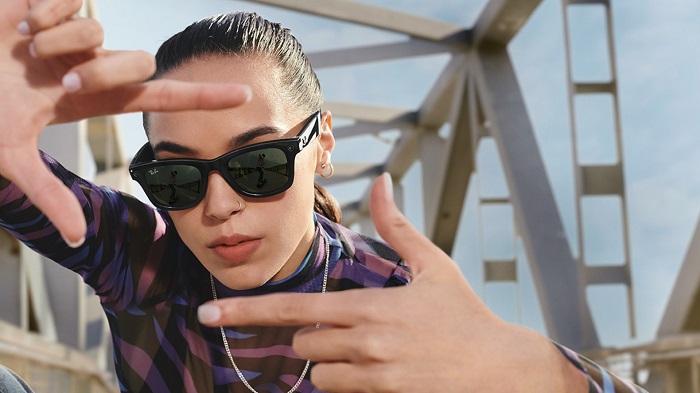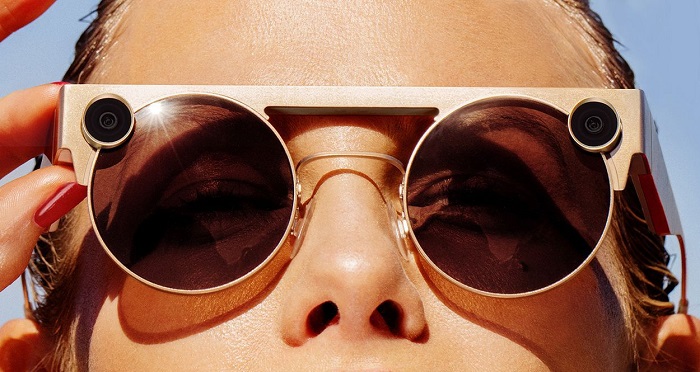ISABEL RUBIO ARROYO | Tungsteno
Recording and taking photos with your eyes. This is the ambitious goal pursued by technology giants such as Facebook, Snapchat and Xiaomi with their smart glasses. These devices also promise other functions such as making calls, listening to music, viewing maps and even translating text in real time. But they do have one drawback: they raise important privacy concerns. Here we take a look at how ready these devices are for the mass market and what hurdles they still need to overcome.
Taking photos and answering calls hands-free
The Facebook glasses, called Ray-Ban Stories, are designed to "capture life’s moments as they happen from a unique, first-person perspective." Equipped with two five-megapixel cameras on their sides and three microphones on their temples, these smart glasses can take photos and record up to 30 seconds of video. They can also answer calls and play music. "Ray-Ban Stories are an important step toward a future when phones are no longer a central part of our lives," said Mark Zuckerberg, founder and CEO of Facebook. These glasses have already gone on sale in some countries such as the United States, Ireland and Italy for around 250 euros.
Facebook is not the only company that has tried to manufacture glasses that complement smartphones. The Spectacles 3, a Snapchat lens available for 370 euros, has four microphones, two cameras and a recording system inspired by the human eye to take photos and videos. The Xiaomi Smart Glasses, which are only a prototype for now, can display messages and notifications, make calls, navigate, take photos and translate texts. Other alternatives don’t take photos or videos. One example is the Huawei X Gentle Monster Eyewear II, smart glasses that cost 329 euros and can be used to play music and talk on the phone. The user can skip songs or adjust the volume by sliding their finger along the temples.
The glasses with cameras are meant to capture life’s moments from a unique, first-person perspective. Credit: Facebook
These types of eyewear could be a prelude to the mass roll-out of virtual and augmented reality glasses. Major companies such as Microsoft, HTC and Lenovo have been investing in this technology for years. According to analysts, even Apple, the company that popularised the iPod, smartphones and smartwatches with the masses, is preparing a virtual reality headset for 2022 and augmented reality glasses for 2023. Early reports indicate that these devices would be used to play games, watch videos and communicate in a 3D digital environment.
While these types of glasses are already being used in the professional workplace, for example to train workers in high-risk environments or to see how the pillars of a building under construction will look, they have not caught on with the general public in the same way. Diego Laforga, head of communications at Isotopy, a company specialising in extended reality, explained in Tungsten that the main problem is the barrier to entry:"Users still have difficulty acquiring a device of this type." In this context, tech giants are looking for the key utility of these glasses so that the public needs them.
The failure of Google's smart glasses
Almost ten years ago, Google introduced its smart glasses: Google Glass, which they hoped would captivate the general public. But the project failed. These glasses had cameras that the wearer could activate at any time, something that was frowned upon in certain quarters. A group called Stop the Cyborgs campaigned against these glasses "to stop a future in which privacy is impossible and central control total." In addition, some public places in the United States banned entry to those who wore them. The Mountain View company then decided to dispense with private users and focus on smart glasses for businesses.
Almost a decade has passed since then. The smart glasses that have come onto the market in recent months are more technologically advanced than Google Glass. In addition to having a more discreet design and being more affordable, they have better cameras and sensors and can record longer videos or store more photos. But the underlying goal remains the same: to make the user less dependent on the mobile phone and to be able to capture content realistically in the first person. What made Google Glass unsuccessful from the outset at the time was not the technical challenges, but concerns over privacy issues.
The tech giants are now aware of the concerns that these smart glasses can raise. But they also know that they face a public used to living among the cameras of thousands of smartphones. "Facebook is not naïve to the fact that other smart glasses have failed in the past," says Jeremy Greenberg, policy counsel for the Future of Privacy Forum, a non-profit organisation partly funded by Facebook. But "the public's expectations of privacy have changed since the days of previous smart glasses launches."
An assault on privacy?
Ray-Ban Stories feature a small light on the side that turns on when you take photos or record: "The Capture LED light lets people know when you're taking a photo or video so you won’t catch anyone near you off guard." Zuckerberg insists that it is already "more than smartphones do." But there are those who believe that this measure might not be enough. Enrique Dans, professor of innovation at IE Business School, points out that Ray-Ban Stories "look like perfectly normal glasses in which the camera is perfectly integrated in a completely unobtrusive way." Although a light comes on when the camera is in use, "it can be very easily overlooked in broad daylight." "That harmless sunglasses become a tool to record with absolute discretion virtually anything that happens around us is something that, at the very least, deserves a certain debate, a minimum social consensus," says Dans.

The Ray-Ban Stories feature a small light on the side that turns on when taking photos or filming. Credit: Facebook
Data Protection organisations in Ireland and Italy have raised concerns in a statement, "about the means by which people captured in the videos and photos can receive notice that they are being recorded." Although mobile phones can also record third parties, they are more "visible" devices at first glance. The organisation Access Now suggests other ways to warn that the wearer of the glasses is recording: "Why not a red light, which is normally associated with recording? Why not add a loud beep before the recording starts? Or give them a unique design to distinguish them from normal Ray-Bans?".
Smart glasses have always been a tough sell. In the midst of the debate over how connected glasses affect privacy, tech companies are trying to navigate failures like Google’s and carve out a niche in the market. It is still too early to tell whether these glasses are ready, at last, to reach a mass audience. For the moment, these devices are evidence of a clear commitment by the tech giants to create wearables that allow you to take photos, make calls or check notifications without using your hands.
· — —
Tungsteno is a journalism laboratory to scan the essence of innovation. Devised by Materia Publicaciones Científicas for Sacyr’s blog.
